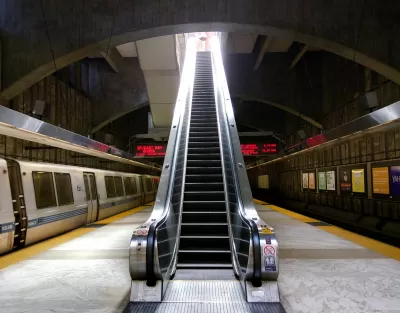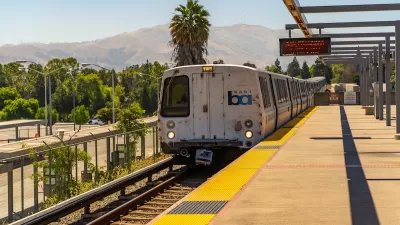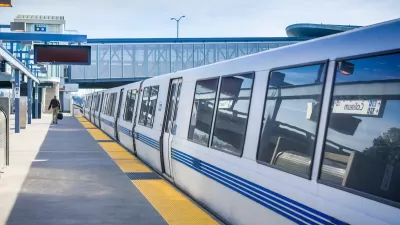Bay Area Rapid Transit, a hugely successful system pre-pandemic, is now struggling to close a massive projected budget gap, with no certain solutions on the table.

Once an agency with the nation’s highest farebox recovery ratio, San Francisco’s Bay Area Rapid Transit (BART) system now faces an uncertain future, writes Ricardo Cano in the San Francisco Chronicle.
With ridership remaining low, “In its worst-case scenario, BART would impose mass layoffs, close on weekends, shutter two of its five lines and nine of its 50 stations and run trains as infrequently as once per hour.” Even worse, “Those deep cuts, agency officials say, could lead to the demise of BART.” Cano outlines the system’s current state, noting that BART will run out of federal funding in January 2025, a situation much more severe for agencies like BART that rely heavily on fare revenue. While officials have proposed a variety of potential solutions, there is no long-term plan yet.
Cano points out that “A Bay Area without BART, however unimaginable, would further fragment public transit, worsen traffic congestion on highways and bridges, and erode the natural flow of a region so profoundly shaped by the rail system.”
BART General Manager Bob Powers says the agency has to change its revenue model. “Instead of relying mostly on fares, we must invert our funding formula to rely more heavily on subsidies and a sustainable source of revenue that recognizes ridership recovery will take years.” California transit agencies are asking for a state subsidy, while BART is pushing for a local ballot measure. But according to Cano, “Newsom’s January budget included $2 billion in cuts to transit projects with no subsidy, highlighting the challenges of securing a state bailout.”
FULL STORY: Could the Bay Area lose BART?

Planetizen Federal Action Tracker
A weekly monitor of how Trump’s orders and actions are impacting planners and planning in America.

Congressman Proposes Bill to Rename DC Metro “Trump Train”
The Make Autorail Great Again Act would withhold federal funding to the system until the Washington Metropolitan Area Transit Authority (WMATA), rebrands as the Washington Metropolitan Authority for Greater Access (WMAGA).

DARTSpace Platform Streamlines Dallas TOD Application Process
The Dallas transit agency hopes a shorter permitting timeline will boost transit-oriented development around rail stations.

Supreme Court Ruling in Pipeline Case Guts Federal Environmental Law
The decision limits the scope of a federal law that mandates extensive environmental impact reviews of energy, infrastructure, and transportation projects.

Texas State Bills to Defund Dallas Transit Die
DART would have seen a 30% service cut, $230M annual losses had the bills survived.

Bikeshare for the Win: Team Pedals to London Cricket Match, Beats Rivals Stuck in Traffic
While their opponents sat in gridlock, England's national cricket team hopped Lime bikes, riding to a 3-0 victory.
Urban Design for Planners 1: Software Tools
This six-course series explores essential urban design concepts using open source software and equips planners with the tools they need to participate fully in the urban design process.
Planning for Universal Design
Learn the tools for implementing Universal Design in planning regulations.
Roanoke Valley-Alleghany Regional Commission
City of Mt Shasta
City of Camden Redevelopment Agency
City of Astoria
Transportation Research & Education Center (TREC) at Portland State University
US High Speed Rail Association
City of Camden Redevelopment Agency
Municipality of Princeton (NJ)





























